Diabetes - Factsheets
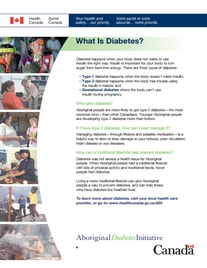
PDF Version — all parts (6.92 MB, 6 pages)
What is Diabetes?

PDF Version part 1 of 6 (1.76 MB, 1 page)

Diabetes happens when your body does not make or use insulin the right way. Insulin is important for your body to turn sugar from food into energy. There are three types of diabetes:
- Type 1 diabetes happens when the body doesn't make insulin;
- Type 2 diabetes happens when the body has trouble using the insulin it makes; and
- Gestational diabetes where the body can't use insulin during pregnancy.
Who gets diabetes?
Aboriginal people are more likely to get type 2 diabetes — the most common kind — than other Canadians. Younger Aboriginal people are developing type 2 diabetes more than before.
If I have type 2 diabetes, how can I best manage it?
Managing diabetes — through lifestyle and possibly medication — is a helpful way to slow or stop damage to your kidneys, poor circulation, heart disease or eye diseases.
How can a traditional lifestyle help prevent diabetes?
Diabetes was not always a health issue for Aboriginal people. When Aboriginal people had a traditional lifestyle with lots of physical activity and traditional foods, fewer people had diabetes.
Living a more traditional lifestyle can give Aboriginal people a way to prevent diabetes, and can help those who have diabetes live healthier lives.
To learn more about diabetes, visit your local health care provider, or go to the Aboriginal Diabetes Initiative information page.
Diabetes: You Are At Risk
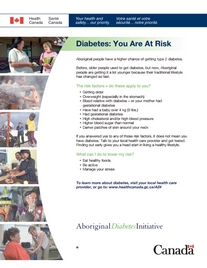
PDF Version part 2 of 6 (1.75 MB, 1 page)

Aboriginal people have a higher chance of getting type 2 diabetes.
Before, older people used to get diabetes, but now, Aboriginal people are getting it a lot younger because their traditional lifestyle has changed so fast.
The risk factors — do these apply to you?
- Getting older
- Overweight (especially in the stomach)
- Blood relative with diabetes — or your mother had gestational diabetes
- Have had a baby over 4 kg (9 lbs.)
- Had gestational diabetes
- High cholesterol and/or high blood pressure
- Higher blood sugar than normal
- Darker patches of skin around your neck
If you answered yes to any of those risk factors, it does not mean you have diabetes. Talk to your local health care provider and get tested. Finding out early gives you a head start in living a healthy lifestyle.
What can I do to lower my risk?
- Eat healthy foods
- Be active
- Manage your stress
To learn more about diabetes, visit your local health care provider, or go to the Aboriginal Diabetes Initiative information page.
Type 2 Diabetes: The Signs
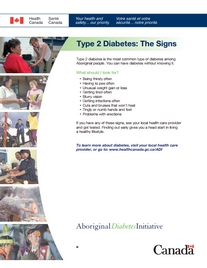
PDF Version part 3 of 6 (1.71 MB, 1 page)

Type 2 diabetes is the most common type of diabetes among Aboriginal people. You can have diabetes without knowing it.
What should I look for?
- Being thirsty often
- Having to pee often
- Unusual weight gain or loss
- Getting tired often
- Blurry vision
- Getting infections often
- Cuts and bruises that won't heal
- Tingly or numb hands and feet
- Problems with erections
If you have any of these signs, see your local health care provider and get tested. Finding out early gives you a head start in living a healthy lifestyle.
To learn more about diabetes, visit your local health care provider, or go to the Aboriginal Diabetes Initiative information page.
Diabetes: Be Active!
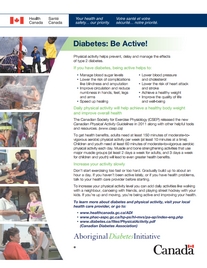
PDF Version part 4 of 6 (1.8 MB, 1 page)

Physical activity helps prevent, delay and manage the effects of type 2 diabetes.
If you have diabetes, being active helps to:
- Manage blood sugar levels
- Lower the risk of complications like blindness and amputation
- Improve circulation and reduce numbness in hands, feet, legs and arms
- Speed up healing
- Lower blood pressure and cholesterol
- Lower the risk of heart attack and stroke
- Achieve a healthy weight
- Improve the quality of life and well-being
Daily physical activity will help achieve a healthy body weight and improve overall health
The Canadian Society for Exercise Physiology (CSEP) released the new Canadian Physical Activity Guidelines in 2011 along with other helpful tools and resources. (www.csep.ca)
To get health benefits, adults need at least 150 minutes of moderate-tovigorous aerobic physical activity per week (at least 10 minutes at a time). Children and youth need at least 60 minutes of moderate-to-vigorous aerobic physical activity each day. Muscle and bone strengthening activities that use major muscle groups (at least 2 days a week for adults, and 3 days a week for children and youth) will lead to even greater health benefits.
Increase your activity slowly
Don't start exercising too fast or too hard. Gradually build up to about an hour a day. If you haven't been active lately, or if you have health problems, talk to your health care provider before starting.
To increase your physical activity level you can add daily activities like walking with a neighbour, canoeing with friends, and playing street hockey with your kids. If you're up and moving, you're being active and improving your health.
You can find additional tips on how to get active by visiting the Public Health Agency of Canada (PHAC) and ParticipACTION's websites.
To learn more about diabetes and physical activity, visit your local health care provider, or go to:
- Aboriginal Diabetes Initiative
- Public Health Agency of Canada — Physical Activity
- Physical activity and diabetes management (Canadian Diabetes Association)
Diabetes: What You Eat Matters
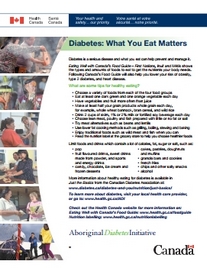
PDF Version part 5 of 6 (1.82 MB, 1 page)

Diabetes is a serious disease and what you eat can help prevent and manage it.
Eating Well with Canada's Food Guide — First Nations, Inuit and Métis shows the types and amounts of foods to eat to get the nutrients your body needs. Following Canada's Food Guide will also help you lower your risk of obesity, type 2 diabetes, and heart disease.
What are some tips for healthy eating?
- Choose a variety of foods from each of the four food groups
- Eat at least one dark green and one orange vegetable each day
- Have vegetables and fruit more often than juice
- Make at least half your grain products whole grain each day, for example, whole wheat bannock, bran cereal, and wild rice
- Drink 2 cups of skim, 1% or 2% milk or fortified soy beverage each day
- Choose lean meat, poultry and fish prepared with little or no fat or salt
- Try meat alternatives such as beans and lentils
- Use lower fat cooking methods such as grilling, boiling, stewing and baking
- Enjoy traditional foods such as wild meat and fish when you can
- Read the nutrition label at the grocery store to help you choose healthier foods
Limit foods and drinks which contain a lot of calories, fat, sugar or salt, such as:
- pop
- fruit flavoured drinks, sweet drinks made from powder, and sports and energy drinks
- candy, chocolate, ice cream and frozen desserts
- cakes, pastries, doughnuts and muffins
- granola bars and cookies
- french fries
- chips and other salty snacks
- alcohol
More information about healthy eating for diabetes is available in Just the Basics from the Canadian Diabetes Association.
To learn more about diabetes, visit your local health care provider, or go to the Aboriginal Diabetes Initiative information page.
Check out the Health Canada website for more information on:
Diabetes and Smoking Don't Mix
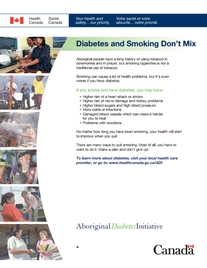
PDF Version part 6 of 6 (1.68 MB, 1 page)

Aboriginal people have a long history of using tobacco in ceremonies and in prayer, but smoking cigarettes is not a traditional use of tobacco.
Smoking can cause a lot of health problems, but it's even worse if you have diabetes.
If you smoke and have diabetes, you may have:
- Higher risk of a heart attack or stroke
- Higher risk of nerve damage and kidney problems
- Higher blood sugars and high blood pressure
- More colds or infections
- Damaged blood vessels which can make it harder for you to heal
- Problems with erections
No matter how long you have been smoking, your health will start to improve when you quit.
There are many ways to quit smoking. Most of all, you have to want to do it. Make a plan and don't give up!
To learn more about diabetes, visit your local health care provider, or go to the Aboriginal Diabetes Initiative information page.